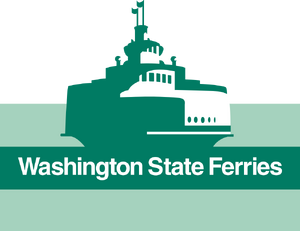Tag: Visual edit |
AJM (Message Wall | contribs) Tag: Visual edit |
||
| Line 4: | Line 4: | ||
The ferry system has its origins in the "mosquito fleet", a collection of small steamer lines serving the [[Puget Sound]] area during the later part of the nineteenth century and early part of the 20th century. By the beginning of the 1930s, two lines remained: the Puget Sound Navigation Company (known as the Black Ball Line) and the Kitsap County Transportation Company. A strike in 1935 forced the KCTC to close, leaving only the Black Ball Line. |
The ferry system has its origins in the "mosquito fleet", a collection of small steamer lines serving the [[Puget Sound]] area during the later part of the nineteenth century and early part of the 20th century. By the beginning of the 1930s, two lines remained: the Puget Sound Navigation Company (known as the Black Ball Line) and the Kitsap County Transportation Company. A strike in 1935 forced the KCTC to close, leaving only the Black Ball Line. |
||
| − | Toward the end of the 1940s the Black Ball Line wanted to increase its fares, to compensate for increased wage demands from the ferry workers' unions, but the state refused to allow this, and so the Black Ball Line shut down. In 1951, the state bought nearly all of Black Ball's ferry assets for $5 million (Black Ball retained five vessels of its fleet). The state intended to run ferry service only until cross-sound bridges could be built, but these were never approved, and the [[Washington State Department of Transportation]] runs the system to this day |
+ | Toward the end of the 1940s the Black Ball Line wanted to increase its fares, to compensate for increased wage demands from the ferry workers' unions, but the state refused to allow this, and so the Black Ball Line shut down. In 1951, the state bought nearly all of Black Ball's ferry assets for $5 million (Black Ball retained five vessels of its fleet). The state intended to run ferry service only until cross-sound bridges could be built, but these were never approved, and the [[Washington State Department of Transportation]] runs the system to this day. |
== Routes == |
== Routes == |
||
Latest revision as of 01:03, 26 April 2019

Washington State Ferries logo.
Washington State Ferries (WSF) is a government agency that operates automobile and passenger ferry service in the state of Washington as part of the Washington State Department of Transportation. It runs ten routes serving 20 terminals located around Puget Sound and in the San Juan Islands, designated as part of the state highway system. The agency maintains the largest fleet of ferries in the United States at 22 vessels, carrying 24.2 million passengers in 2016. As of 2017, it was the largest ferry operator in the United States, and the fourth-largest ferry system in the world.
History
The ferry system has its origins in the "mosquito fleet", a collection of small steamer lines serving the Puget Sound area during the later part of the nineteenth century and early part of the 20th century. By the beginning of the 1930s, two lines remained: the Puget Sound Navigation Company (known as the Black Ball Line) and the Kitsap County Transportation Company. A strike in 1935 forced the KCTC to close, leaving only the Black Ball Line.
Toward the end of the 1940s the Black Ball Line wanted to increase its fares, to compensate for increased wage demands from the ferry workers' unions, but the state refused to allow this, and so the Black Ball Line shut down. In 1951, the state bought nearly all of Black Ball's ferry assets for $5 million (Black Ball retained five vessels of its fleet). The state intended to run ferry service only until cross-sound bridges could be built, but these were never approved, and the Washington State Department of Transportation runs the system to this day.
Routes
Fleet
As of 2017, there are 22 ferries on Puget Sound operated by the state. The largest vessels in this fleet carry up to 2500 passengers and 202 vehicles. They are painted in a distinctive white and green trim paint scheme, and feature double-ended open vehicle decks and bridges at each end so that they do not need to turn around.
Retired Vessels
Since the beginning of state-run ferry service in 1951, WSF has retired many vessels as they have become older, too expensive to operate or maintain, or have become too small to provide adequate ferry service. WSF owned passenger-only vessels between 1985 and 2009, but after discontinuing its two passenger-only routes in the 2000s, WSF has sold its passenger-only ferries to other operators.
